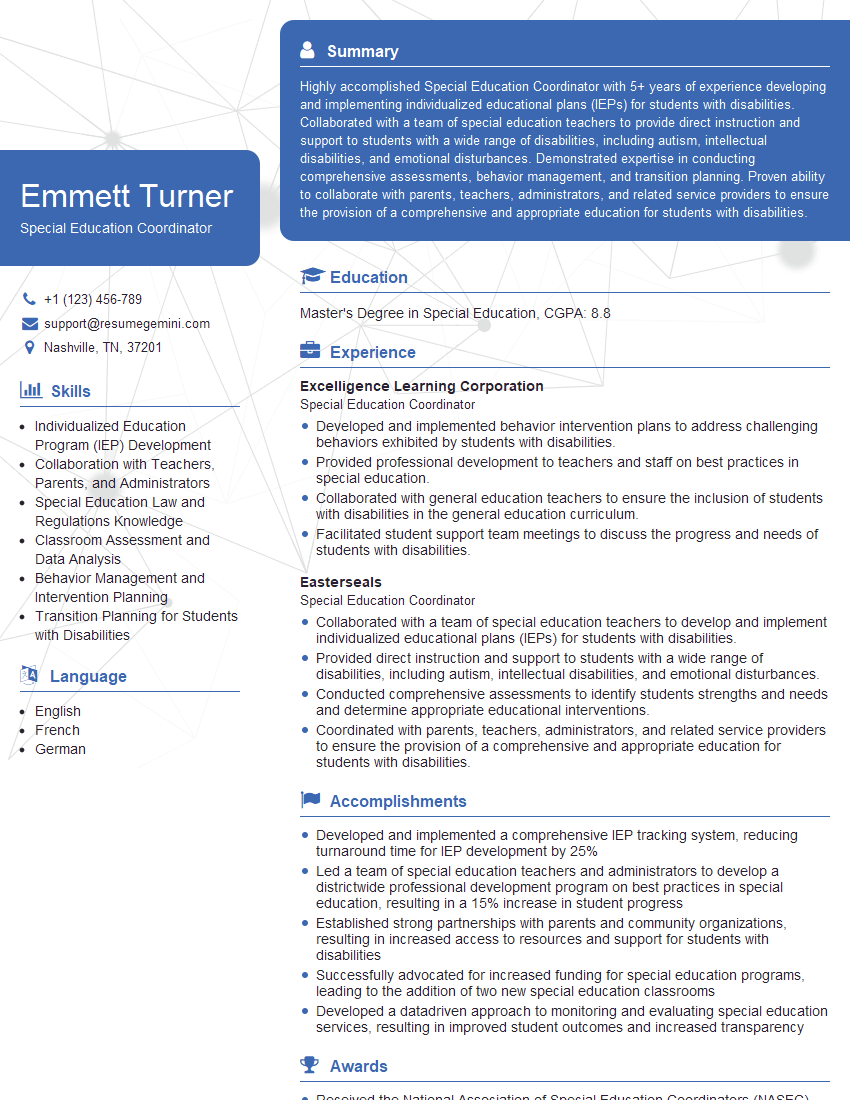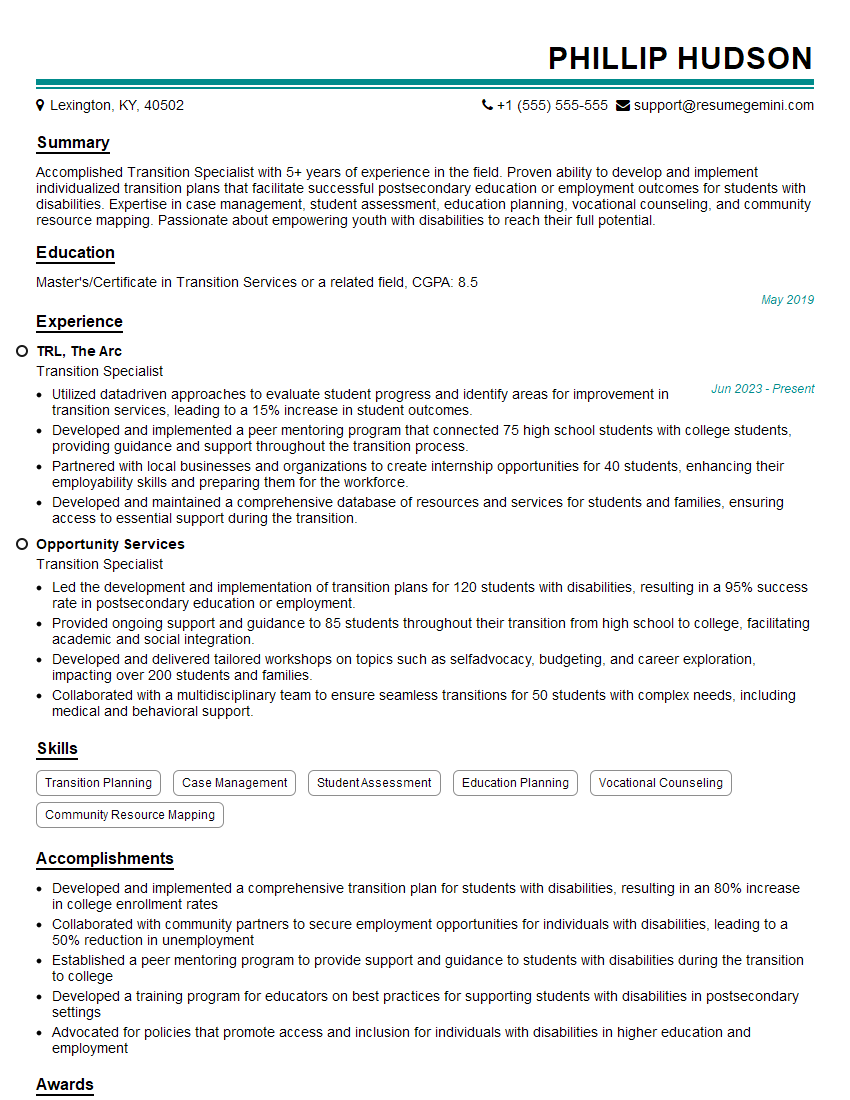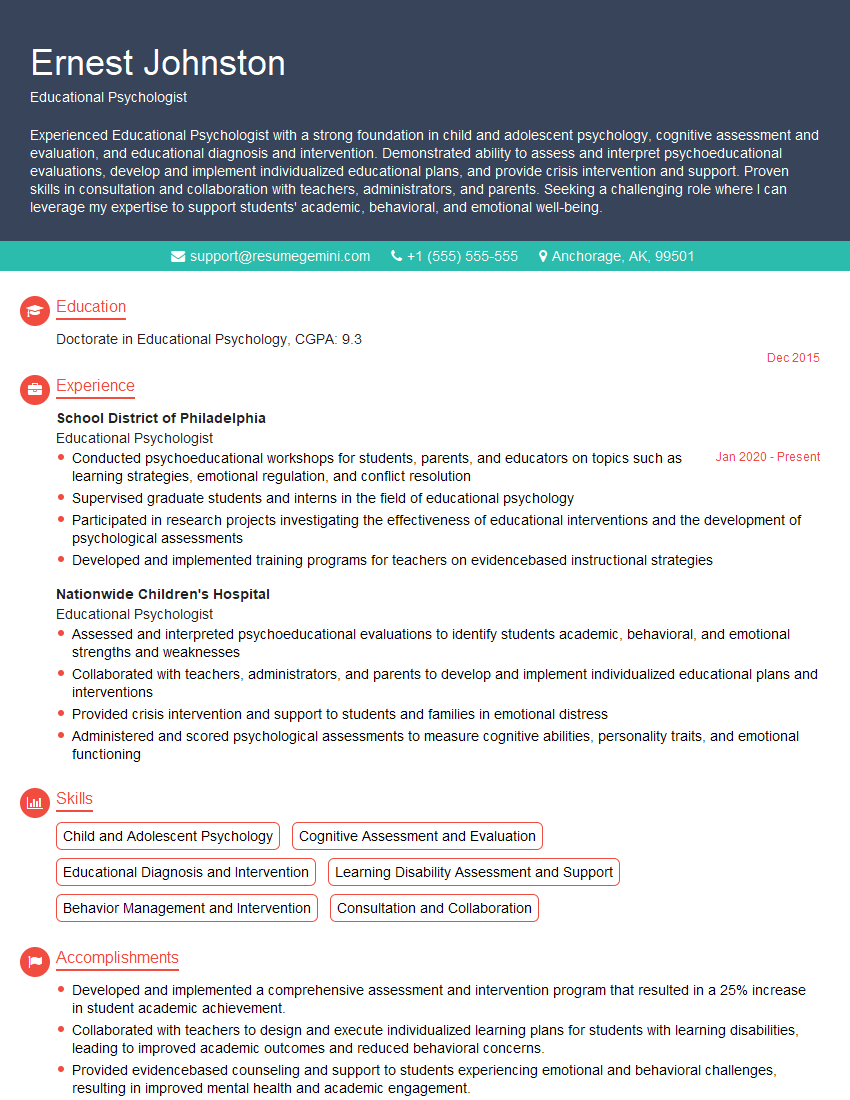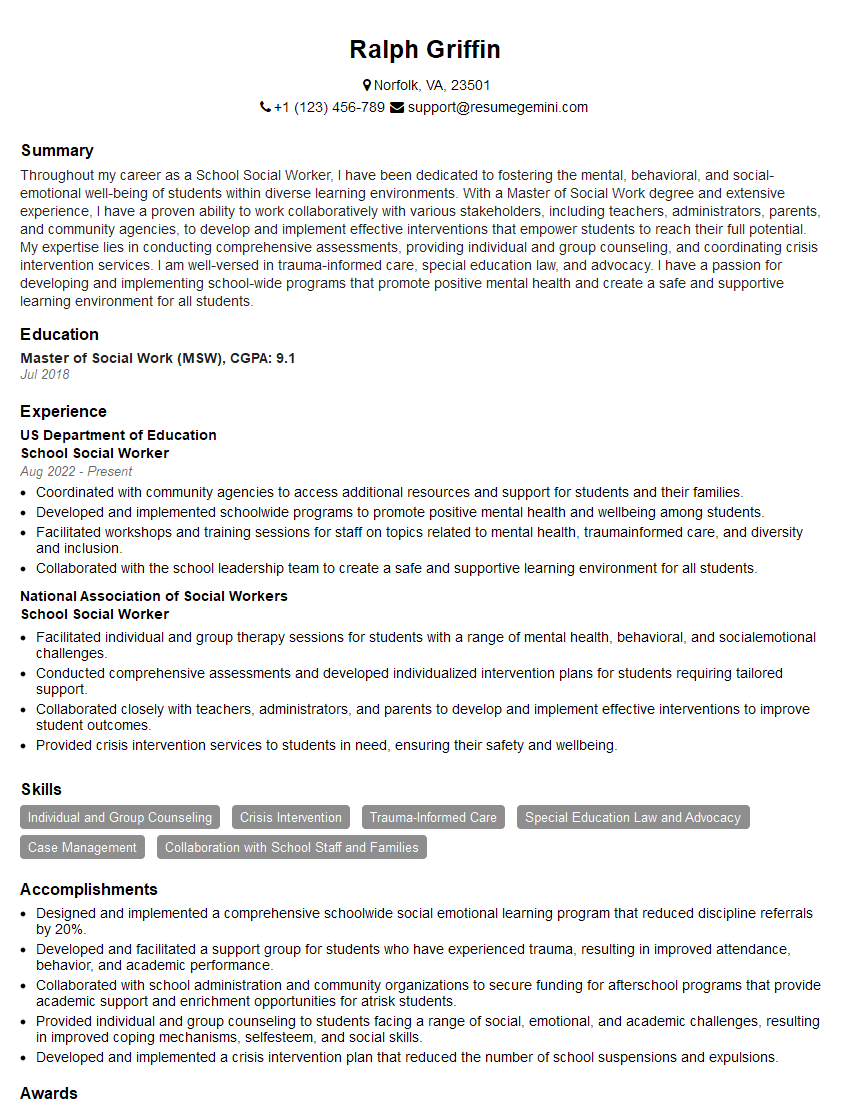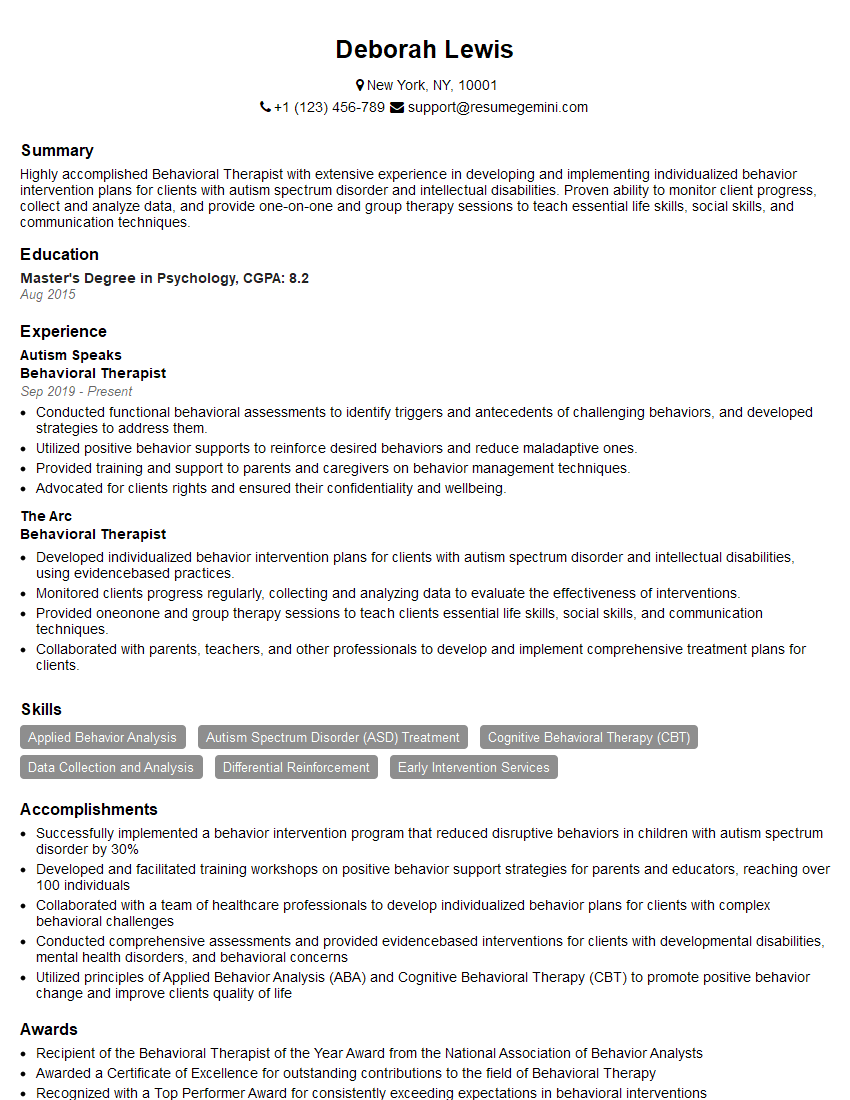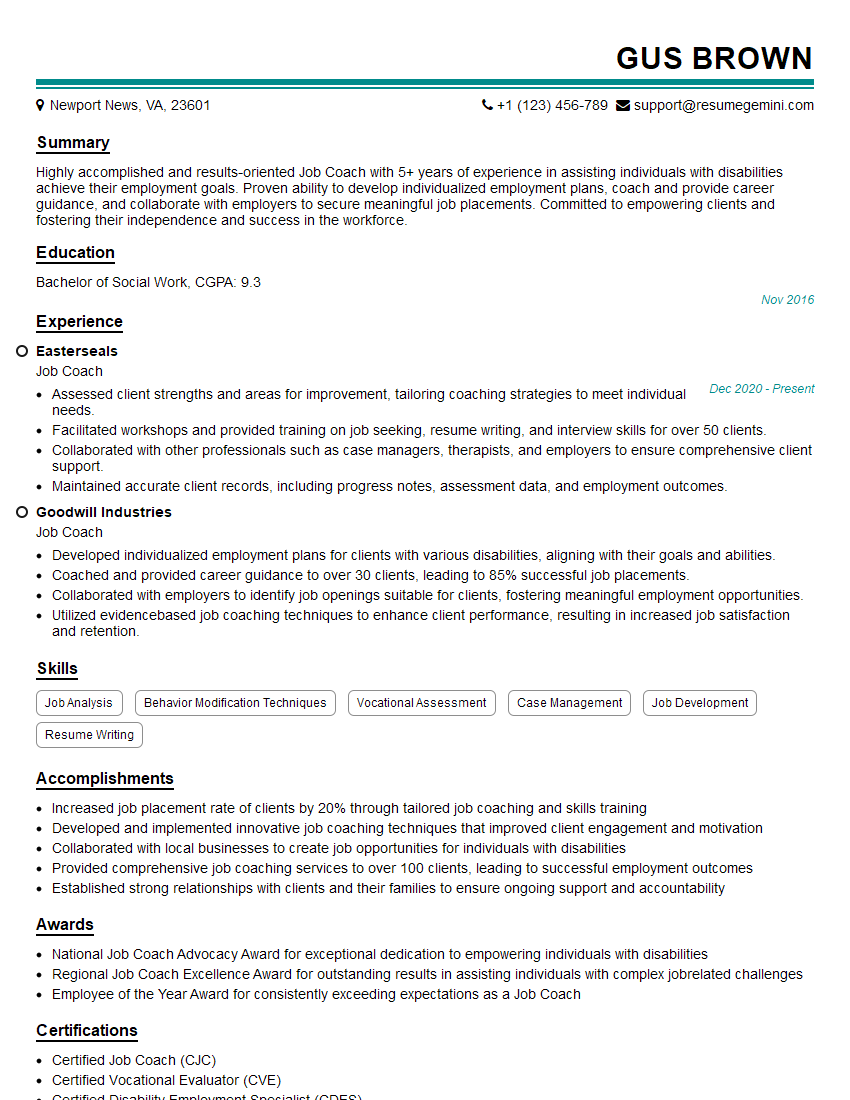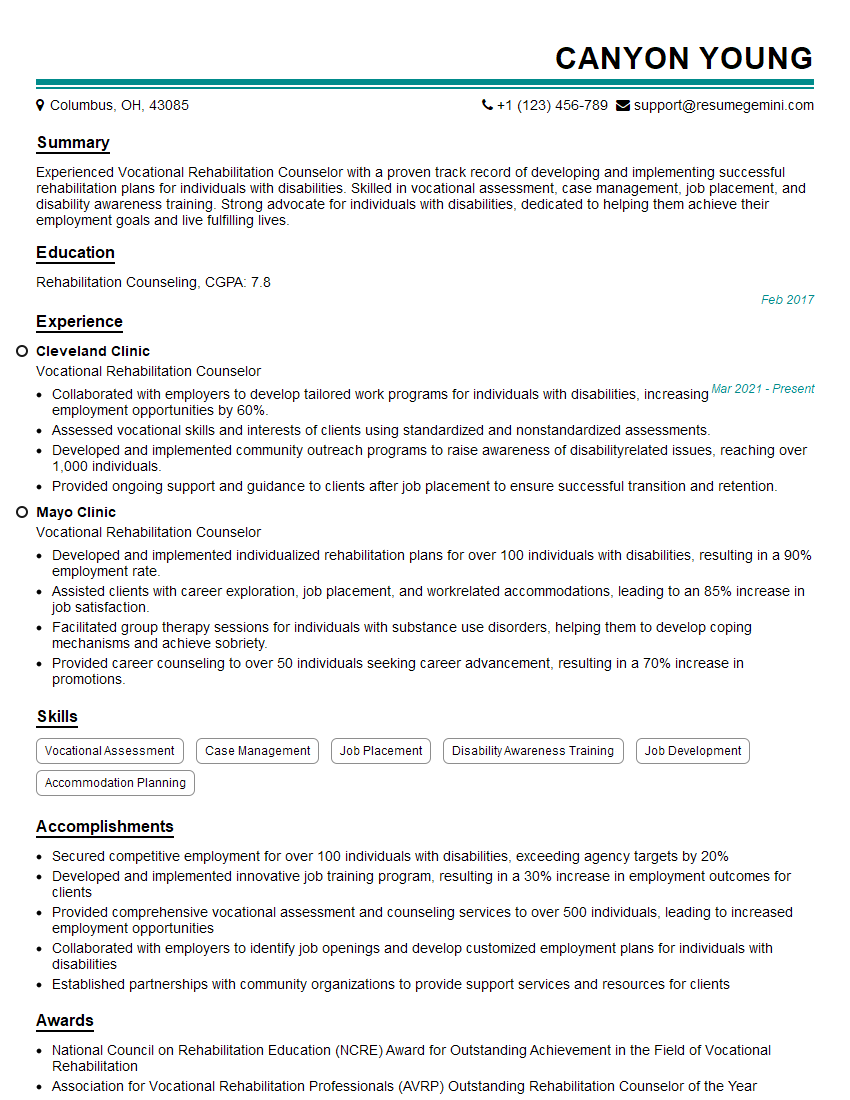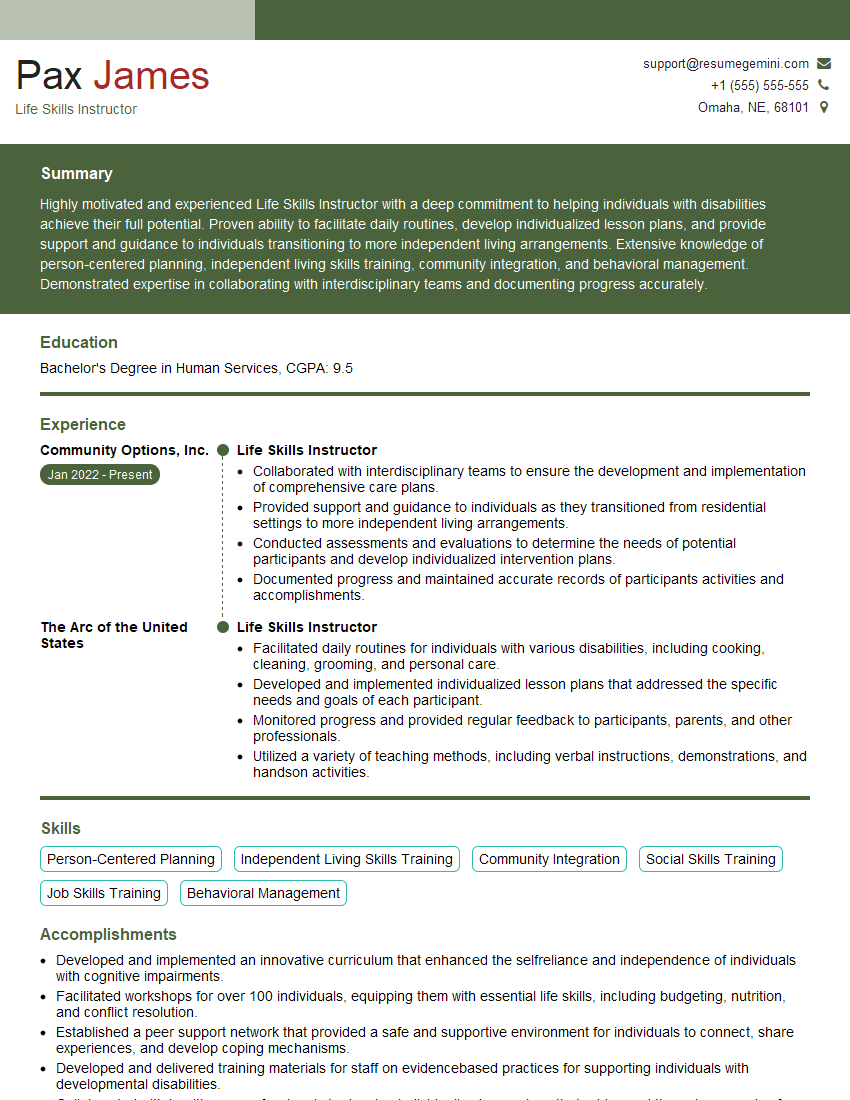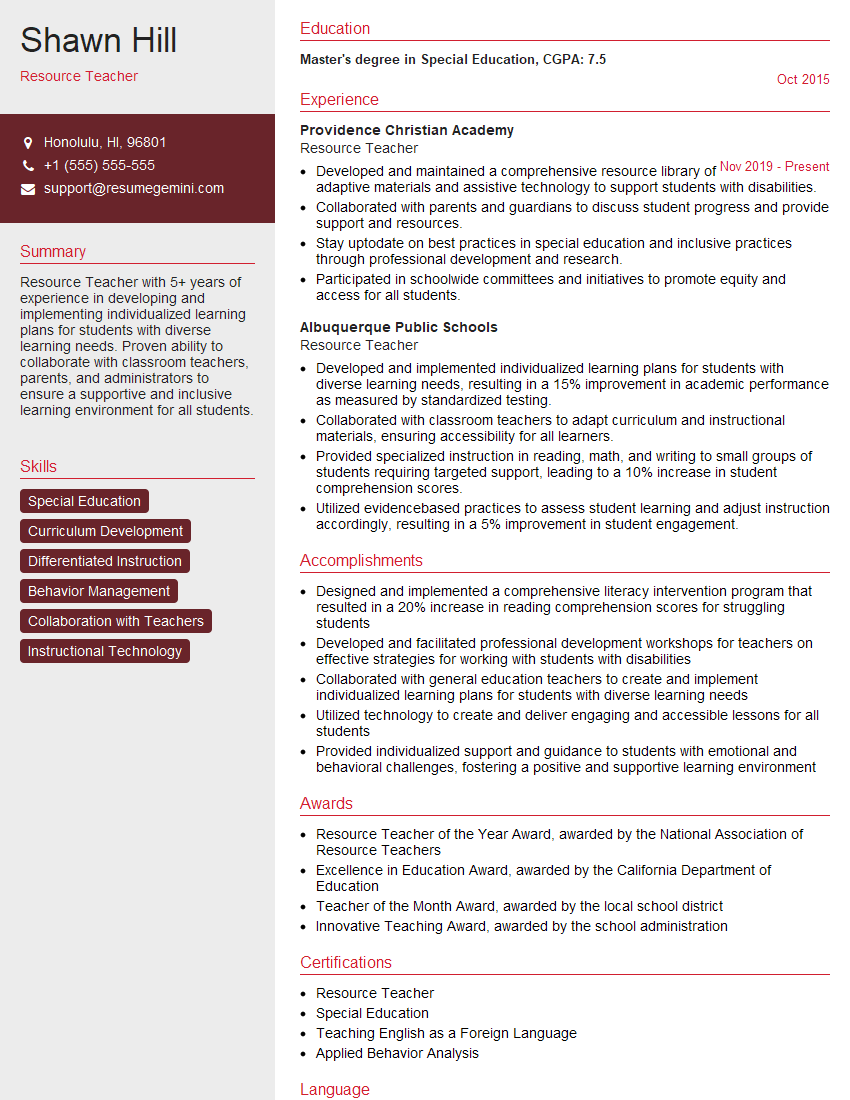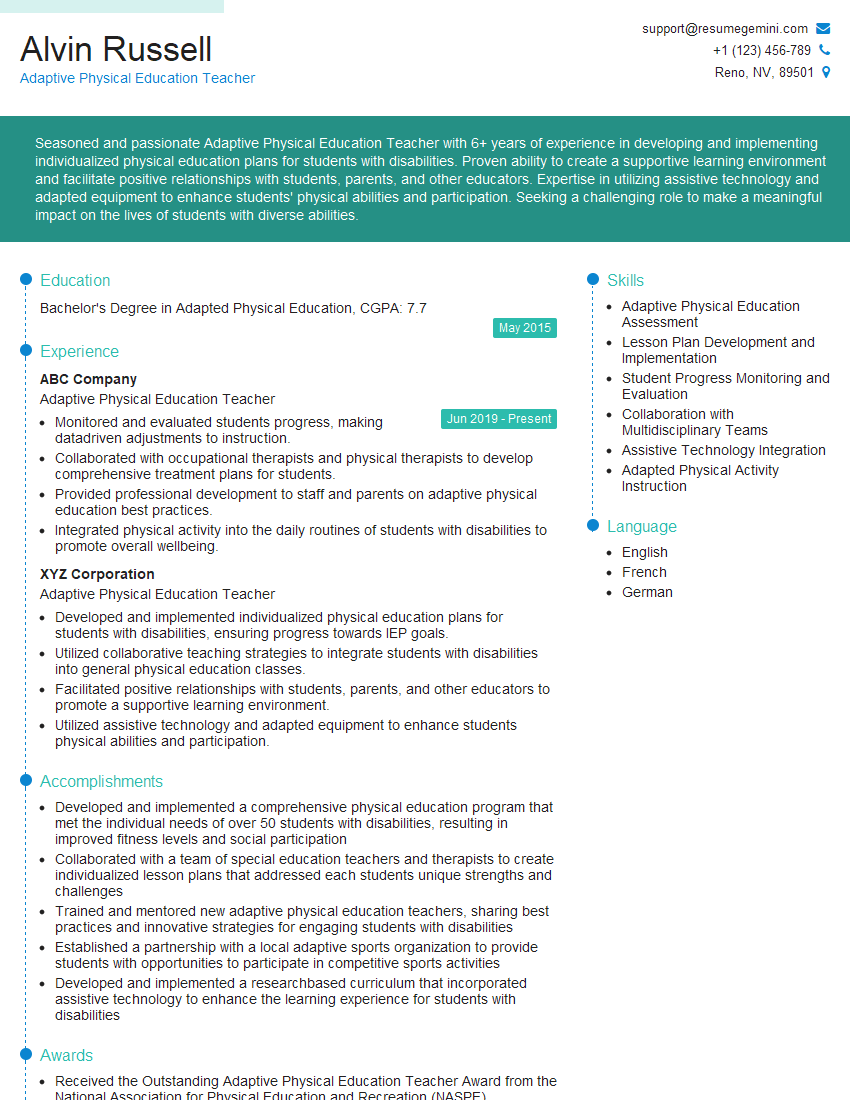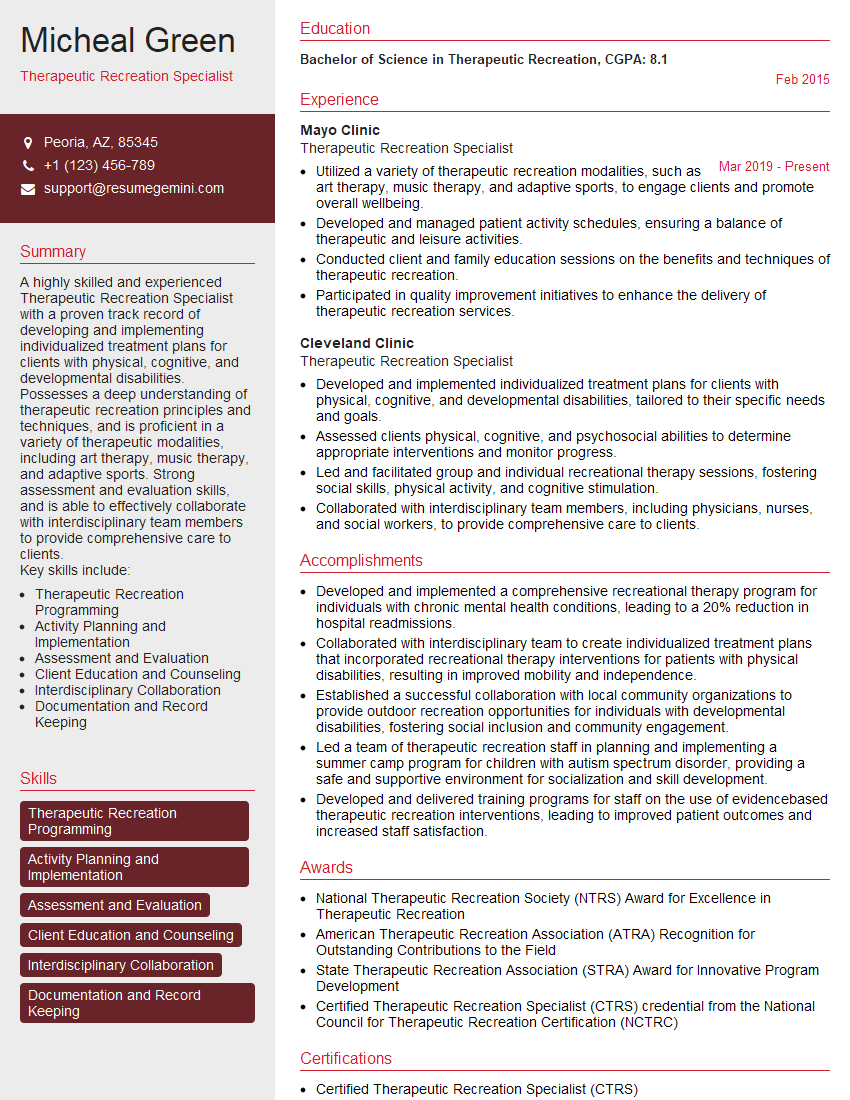Cracking a skill-specific interview, like one for Functional Skills Training for Students with Mental Handicaps, requires understanding the nuances of the role. In this blog, we present the questions you’re most likely to encounter, along with insights into how to answer them effectively. Let’s ensure you’re ready to make a strong impression.
Questions Asked in Functional Skills Training for Students with Mental Handicaps Interview
Q 1. Describe your experience adapting curriculum for students with diverse learning needs.
Adapting curriculum for students with diverse learning needs is crucial for ensuring their success. It involves moving beyond a one-size-fits-all approach and creating personalized learning experiences that cater to individual strengths and challenges. This means understanding various learning styles, cognitive abilities, and physical limitations.
For example, a student with autism might benefit from visual aids and structured routines, while a student with ADHD might require frequent breaks and opportunities for movement. I assess a student’s needs through observation, standardized tests, and collaboration with parents and other professionals. Then, I modify the curriculum’s content, delivery method, and assessment strategies to meet their individual requirements. This can involve breaking down complex tasks into smaller, manageable steps, providing alternative assignments, offering choices in activities, or using assistive technology. I recently adapted a geometry unit for a student with a visual processing disorder by using kinesthetic activities with manipulatives, substituting written tests with verbal or practical assessments.
Q 2. Explain your understanding of Individualized Education Programs (IEPs).
An Individualized Education Program (IEP) is a legally mandated document outlining specific educational goals and support services for students with disabilities. It’s a collaborative effort involving educators, parents, the student (when appropriate), and other professionals. The IEP identifies the student’s present levels of performance, establishes measurable annual goals, and details the specific services and accommodations required to help the student achieve those goals. Think of it as a personalized roadmap for a student’s educational journey.
For instance, an IEP might specify the use of assistive technology like text-to-speech software for a student with dyslexia, or provide for specialized instruction in social skills for a student with autism. Regular monitoring and review of the IEP are vital to ensure its effectiveness and adjust it as the student’s needs evolve.
Q 3. How would you assess a student’s functional skills in daily living?
Assessing a student’s functional skills in daily living involves evaluating their ability to perform everyday tasks independently. This goes beyond academic skills and focuses on practical competencies necessary for self-sufficiency. I employ a multifaceted approach, including:
- Observations: Watching the student perform tasks in a natural setting (e.g., getting dressed, preparing a simple meal).
- Interviews: Talking to the student and their caregivers to understand their abilities and challenges.
- Checklists and Rating Scales: Using standardized tools to systematically assess specific skills (e.g., personal care, money management).
- Role-Playing and Simulations: Creating scenarios to observe the student’s ability to handle real-life situations.
For example, I might assess a student’s ability to manage their money by giving them a simulated shopping trip, or their ability to follow a recipe by having them prepare a simple snack. The assessment results inform the development of individualized goals and interventions focused on improving their functional skills.
Q 4. What strategies do you use to promote independence in students with mental handicaps?
Promoting independence in students with mental handicaps requires a patient, structured, and supportive approach. It’s about empowering them to manage their lives as much as possible. Key strategies include:
- Breaking down tasks: Dividing complex tasks into smaller, manageable steps.
- Positive reinforcement: Rewarding progress and achievements to build confidence.
- Visual supports: Using pictures, schedules, and checklists to improve organization and understanding.
- Role-playing and simulations: Practicing real-life scenarios to build competence.
- Gradual release of responsibility: Slowly transferring responsibility for tasks from the educator to the student.
For instance, I helped a student learn to independently prepare a simple breakfast by first guiding them through each step, then gradually reducing my assistance until they could complete the task on their own. Consistent support and celebrating small victories are crucial for fostering a sense of accomplishment and independence.
Q 5. How do you incorporate assistive technology into your teaching?
Assistive technology plays a vital role in supporting students with mental handicaps. I integrate it thoughtfully and strategically to enhance learning and independence. This might involve:
- Communication devices: Augmentative and alternative communication (AAC) devices like picture exchange systems (PECS) or speech-generating devices (SGD).
- Adaptive learning software: Programs that provide customized learning experiences and adapt to the student’s pace and needs.
- Organizational tools: Digital calendars, reminder apps, and task management software.
- Sensory aids: Noise-canceling headphones, weighted blankets, or other tools that address sensory sensitivities.
For example, I’ve used speech-to-text software to help a student with written expression difficulties participate more actively in class discussions. The choice of assistive technology is always personalized to the student’s specific needs and learning style.
Q 6. Describe your experience working with students with specific learning disabilities (e.g., dyslexia, ADHD).
My experience with students with specific learning disabilities like dyslexia and ADHD emphasizes the importance of differentiated instruction and individualized support. Dyslexia requires focusing on phonological awareness and multisensory teaching techniques, while ADHD necessitates strategies for managing attention and impulsivity. This often involves:
- Modified assignments: Providing shorter assignments or allowing extra time for completion.
- Alternative assessment methods: Using verbal or practical assessments instead of written tests.
- Assistive technology: Utilizing text-to-speech software, graphic organizers, or other tools.
- Behavioral strategies: Implementing techniques to manage attention and reduce distractions.
For instance, I’ve used color-coded organizers to help a student with ADHD stay organized, and I’ve provided audio recordings of reading materials for a student with dyslexia. Understanding the specific challenges posed by each disability is essential for tailoring effective support strategies.
Q 7. How do you address challenging behaviors in the classroom?
Addressing challenging behaviors in the classroom requires a proactive and multi-faceted approach focusing on understanding the underlying causes of the behavior. It’s crucial to avoid punitive measures and instead focus on positive interventions. My strategies include:
- Functional Behavior Assessment (FBA): Identifying the triggers, functions, and consequences of the behavior to understand its purpose.
- Behavior Intervention Plan (BIP): Developing a plan based on the FBA to teach alternative behaviors and prevent challenging behaviors.
- Positive reinforcement: Rewarding appropriate behaviors to encourage their repetition.
- Environmental modifications: Adjusting the classroom environment to minimize triggers for challenging behaviors.
- Collaboration: Working closely with parents and other professionals to provide consistent support.
For instance, if a student is exhibiting disruptive behaviors due to frustration with a task, I would modify the task, provide additional support, and reward the student for completing parts of the task successfully. Consistency and collaboration are key to effectively managing challenging behaviors.
Q 8. Explain your approach to creating a supportive and inclusive learning environment.
Creating a supportive and inclusive learning environment for students with mental handicaps is paramount. It’s about fostering a sense of belonging, safety, and respect where every student feels valued and empowered to learn. My approach is multifaceted and focuses on several key areas:
- Positive and predictable classroom structure: A consistent routine helps students feel secure and reduces anxiety. This includes clear expectations, visual schedules, and consistent transitions between activities.
- Individualized learning plans: Recognizing that each student is unique, I develop tailored plans focusing on their strengths and addressing their specific learning needs and challenges.
- Universal Design for Learning (UDL) principles: I incorporate UDL principles to provide multiple means of representation, action, and engagement. This allows students to access information and demonstrate learning in ways that best suit their individual learning styles and abilities.
- Collaborative learning opportunities: Students learn from each other through peer tutoring and group activities designed to promote social interaction and cooperation. This also helps build social skills and self-esteem.
- Positive reinforcement and encouragement: Focusing on celebrating successes, no matter how small, and offering constructive feedback rather than focusing solely on deficits.
- Sensory considerations: Creating a calm and stimulating learning environment. This could involve adjusting lighting, sound levels, and even incorporating sensory breaks into the day.
For instance, one student I worked with had significant anxiety. By implementing a visual schedule and providing him with a quiet corner for breaks, we significantly improved his participation and overall well-being in class.
Q 9. How do you differentiate instruction to meet the needs of individual students?
Differentiation is key to meeting the diverse needs of students with mental handicaps. It’s not about lowering expectations, but about adapting the *how* of learning to best suit the individual. My approach involves:
- Assessing individual strengths and weaknesses: Thorough assessments, including observations, standardized tests, and informal measures, identify the student’s specific learning style, cognitive abilities, and areas for improvement.
- Adapting materials and activities: This can include modifying the complexity of tasks, providing visual aids, using alternative formats (e.g., audiobooks, large print), and breaking down complex tasks into smaller, more manageable steps.
- Adjusting pacing and instructional methods: Some students may need more time to complete tasks, while others may thrive with a faster pace. Different instructional methods, such as hands-on activities, role-playing, and real-world applications, can cater to diverse learning styles.
- Providing varied levels of support: Some students may need more one-on-one support, while others may benefit from peer tutoring or collaborative learning. I adjust my level of support to meet the individual needs of each student.
For example, one student struggled with reading comprehension. I adapted the lesson by using graphic organizers, pre-teaching key vocabulary, and providing audiobooks alongside the text. This multi-sensory approach greatly improved his comprehension.
Q 10. What methods do you use to track student progress and make data-driven decisions?
Tracking student progress and making data-driven decisions is essential for effective instruction. My methods include:
- Regular formative assessments: Frequent quizzes, observation checklists, and informal assessments throughout the learning process provide ongoing feedback on student understanding.
- Summative assessments: Unit tests and projects assess mastery of key concepts at the end of a learning unit.
- Data collection and analysis: I meticulously record student performance data, analyzing trends to identify areas where students excel and areas needing additional support.
- Individualized Education Program (IEP) goals: Progress towards IEP goals is regularly monitored and adjustments are made to the learning plan as needed.
- Data visualization: Charts and graphs help to visualize progress over time and provide a clear picture of student achievement.
For instance, if data shows a student struggling with a particular skill, I can adjust my instructional methods, provide additional support, or modify the learning objectives. This ensures that instruction remains relevant and effective.
Q 11. Describe your experience collaborating with parents and other professionals.
Collaboration with parents and other professionals is vital. My approach involves:
- Open communication: Regular communication with parents through newsletters, phone calls, and parent-teacher conferences keeps them informed about their child’s progress and any concerns.
- Shared decision-making: I involve parents in the development and implementation of IEPs, ensuring that their insights and preferences are considered.
- Collaboration with other professionals: I work closely with special education teachers, therapists (occupational, physical, speech), and school counselors to create a cohesive and supportive learning environment.
- Team meetings: Regular team meetings allow for the sharing of information, collaborative problem-solving, and the coordination of services.
For example, working with a student’s speech therapist allowed us to coordinate strategies for improving communication skills both in the classroom and at home. This holistic approach resulted in significant progress.
Q 12. How do you ensure the safety and well-being of your students?
Ensuring student safety and well-being is my top priority. This involves:
- Creating a safe and supportive classroom environment: Establishing clear rules and expectations, promoting positive relationships, and addressing bullying or other forms of harassment promptly.
- Following school safety protocols: Adhering to all school policies and procedures related to safety, emergency procedures, and student supervision.
- Developing crisis intervention skills: I am trained in de-escalation techniques and crisis intervention strategies to handle challenging behaviors safely and effectively.
- Working with school support staff: I collaborate with school counselors, social workers, and administrators to provide appropriate support and intervention for students who are experiencing emotional or behavioral challenges.
- Maintaining confidentiality: I strictly adhere to student privacy laws and regulations.
For instance, we implemented a buddy system to help a student who was prone to wandering off during class, ensuring their safety and reducing anxiety.
Q 13. How would you adapt a lesson plan for a student with limited communication skills?
Adapting a lesson plan for a student with limited communication skills requires a focus on alternative methods of expression and understanding.
- Visual supports: Using pictures, symbols, and other visual aids to enhance comprehension and provide alternative ways for the student to communicate. This might include using visual schedules, picture cards, or communication boards.
- Hands-on activities: Incorporating more tactile and kinesthetic activities to make learning engaging and accessible. This could involve using manipulatives, role-playing, or other hands-on learning experiences.
- Augmentative and alternative communication (AAC): Utilizing AAC devices or strategies, such as sign language, picture exchange systems (PECS), or speech-generating devices, to support communication.
- Simplified language and instructions: Using shorter sentences, simpler vocabulary, and clear, concise directions.
- Modeling desired responses: Demonstrating appropriate communication behaviors and providing opportunities for the student to imitate and practice.
For example, instead of asking a student to verbally describe a historical event, I might use picture cards for them to sequence the events chronologically and then use a communication board to express their understanding.
Q 14. Describe your experience with various types of augmentative and alternative communication (AAC).
My experience with AAC is extensive and encompasses various methods. I’ve worked with students using a variety of systems:
- Picture Exchange Communication System (PECS): This is a very effective system for non-verbal students, especially those with autism, where they exchange pictures to communicate needs and wants.
- Sign language: I’m proficient in American Sign Language (ASL) and have incorporated it into lessons to support students with limited verbal skills.
- Speech-generating devices (SGD): I’ve worked with students using SGDs, where they select words or phrases on a screen to communicate. The devices can range from simple to highly sophisticated.
- Low-tech AAC: I’ve utilized simple communication boards, picture cards, and other low-tech tools to help students communicate effectively.
- Communication apps: Some students benefit from using communication apps on tablets or smartphones, providing a more flexible and accessible way to communicate.
The key is to select the most appropriate AAC system based on the individual student’s needs, abilities, and communication preferences. It is often a collaborative process involving the student, parents, and other professionals.
Q 15. What strategies do you use to build rapport with students with mental handicaps?
Building rapport with students with mental handicaps is crucial for effective learning. It’s about creating a safe and trusting environment where students feel comfortable, understood, and respected. This isn’t a one-size-fits-all approach; it requires patience, observation, and a genuine desire to connect with each individual.
- Positive Reinforcement: I focus on celebrating even small successes, using positive language and non-verbal cues like smiles and nods to show encouragement. For example, if a student manages to complete a simple task, I’ll praise their effort and focus on their strengths.
- Patience and Understanding: I understand that communication and learning styles can vary significantly. I adapt my communication style based on individual needs, using simple language, visual aids, and clear instructions. I’m also prepared for potential communication delays or misunderstandings. If a student struggles with a particular concept, I break it down into smaller, manageable steps.
- Active Listening: I actively listen to their verbal and nonverbal communication, paying close attention to body language and emotional cues. This allows me to understand their needs and adjust my approach accordingly. For instance, a student might become restless or withdrawn, indicating a need for a break or a change of activity.
- Consistency and Routine: Establishing a predictable routine and consistent expectations helps create a sense of security and reduces anxiety. This creates a foundation for trust and successful learning.
Ultimately, building rapport is an ongoing process. It’s about fostering a relationship built on mutual respect, trust, and understanding, creating a positive learning experience that empowers students to achieve their full potential.
Career Expert Tips:
- Ace those interviews! Prepare effectively by reviewing the Top 50 Most Common Interview Questions on ResumeGemini.
- Navigate your job search with confidence! Explore a wide range of Career Tips on ResumeGemini. Learn about common challenges and recommendations to overcome them.
- Craft the perfect resume! Master the Art of Resume Writing with ResumeGemini’s guide. Showcase your unique qualifications and achievements effectively.
- Don’t miss out on holiday savings! Build your dream resume with ResumeGemini’s ATS optimized templates.
Q 16. How do you support students’ transition to post-secondary education or employment?
Supporting students’ transition to post-secondary education or employment requires a multifaceted approach that begins long before the transition itself. It’s about preparing them for the independence and challenges they will face.
- Vocational Training and Skill Development: We incorporate practical skills training into our curriculum, focusing on areas relevant to potential employment. This includes hands-on experience, job shadowing, and mock interviews. For example, we’ve had successful programs teaching basic computer skills, food service preparation, and basic gardening.
- Life Skills Training: Equally important is training in essential life skills like money management, public transportation, and independent living. We use role-playing, simulations, and real-world scenarios to help students practice these skills.
- Collaboration with Support Services: We work closely with vocational rehabilitation counselors, job placement agencies, and post-secondary institutions to ensure a smooth transition. This includes sharing progress reports, attending meetings, and coordinating services to meet individual needs.
- Individualized Transition Plans (ITPs): We develop individualized transition plans collaboratively with the student, their family, and relevant professionals. These plans outline specific goals, strategies, and support needed to ensure a successful transition.
- Mentorship Programs: Connecting students with mentors who have successfully navigated similar transitions provides valuable guidance and support.
By proactively addressing their individual needs and fostering strong collaborations with external partners, we help students gain the skills, confidence, and support they need to thrive in their chosen path after leaving our program.
Q 17. How do you involve students in setting their own learning goals?
Involving students in setting their own learning goals is paramount for fostering motivation and ownership of their learning journey. It’s about empowering them to take an active role in their education.
- Visual Supports: We utilize visual aids like pictures, charts, and checklists to help students understand and track their progress toward their goals. This is especially helpful for students with visual learning preferences.
- Simple Language and Clear Expectations: We use simple, straightforward language to explain the goal-setting process. Goals are broken down into smaller, manageable steps with clearly defined expectations.
- Choice and Autonomy: Offering choices within the learning process allows students to feel a sense of control and empowers them to take ownership of their learning. This might involve letting them choose from different activities related to a specific skill or topic.
- Collaboration and Feedback: We work collaboratively with students to establish their goals, regularly providing feedback and making adjustments as needed. This continuous process ensures their goals remain relevant, attainable, and motivating.
- Regular Check-ins and Review: We regularly review progress with students to maintain motivation and address any challenges that might arise. This helps them stay on track and reinforces their achievements.
By involving students in this process, we nurture their independence, self-advocacy, and overall engagement in their learning.
Q 18. Describe your experience with behavior intervention plans (BIPs).
Behavior Intervention Plans (BIPs) are crucial for addressing challenging behaviors and creating a positive learning environment for all students. They are not punitive but rather proactive strategies designed to understand and support the student’s needs. My experience with BIPs involves a collaborative, data-driven approach.
- Functional Behavior Assessment (FBA): The process always starts with a comprehensive FBA to identify the function of the behavior – what need or purpose it serves for the student. This helps us understand the ‘why’ behind the behavior, rather than simply focusing on the ‘what’.
- Positive Behavior Support (PBS): BIPs are rooted in PBS, which emphasizes teaching positive behaviors rather than solely addressing negative ones. This involves identifying and reinforcing replacement behaviors that serve the same function as the challenging behavior, but in a more appropriate way.
- Data Collection and Monitoring: We meticulously track the frequency, intensity, and duration of the target behavior, as well as the effectiveness of the interventions. This data-driven approach allows us to adjust the BIP as needed.
- Team Collaboration: Developing and implementing a BIP is a collaborative effort involving the student (when possible), parents, therapists, administrators, and other relevant professionals. This ensures a consistent approach across all settings.
- Regular Review and Modification: BIPs are not static documents. They are regularly reviewed and modified based on the data collected and the student’s progress. Flexibility and adaptability are key to their effectiveness.
For example, a student might exhibit disruptive behavior in class due to anxiety. A BIP might include strategies like providing a quiet workspace, teaching relaxation techniques, and offering breaks when needed. The success of the BIP is continuously monitored and the plan adapted as the student progresses.
Q 19. How do you adapt physical activities to meet the needs of students with physical limitations?
Adapting physical activities for students with physical limitations requires careful consideration of individual needs and capabilities. It’s about creating inclusive opportunities for participation and enjoyment, not exclusion.
- Individualized Modifications: We tailor activities to each student’s specific physical abilities and limitations. This may involve modifying the rules, equipment, or environment to make the activity accessible. For example, a student with limited mobility might participate in a modified version of a team sport, or use adaptive equipment.
- Assistive Technology: We utilize assistive technology, such as wheelchairs, walkers, or adaptive equipment, to ensure full participation. We also explore the use of technology to enhance the learning experience in different ways.
- Alternative Activities: We provide alternative activities for students unable to fully participate in the planned physical activity. These alternatives should be engaging, meaningful, and offer similar developmental benefits.
- Collaboration with Therapists: We closely collaborate with physical and occupational therapists to understand each student’s limitations and capabilities and to ensure the chosen activities are appropriate and safe.
- Focus on Functional Movement: We prioritize activities that promote functional movement and enhance daily living skills, emphasizing both strength and endurance.
The goal is to create an inclusive environment where all students can participate in physical activities that promote their physical, social, and emotional well-being, regardless of their physical limitations.
Q 20. How do you promote social skills development in students with mental handicaps?
Promoting social skills development in students with mental handicaps requires a structured and supportive approach that focuses on teaching, practicing, and reinforcing appropriate social behaviors in a variety of settings.
- Social Skills Training Programs: We utilize evidence-based social skills training programs that focus on specific skills like turn-taking, active listening, conflict resolution, and appropriate communication styles. These programs often incorporate role-playing, modeling, and feedback.
- Social Stories and Visual Aids: Social stories and visual aids help students understand social situations, expectations, and appropriate responses. These tools break down complex social situations into manageable steps.
- Peer Support and Collaboration: We create opportunities for students to interact with their peers in positive and supportive settings. Peer mentoring and buddy systems can be highly effective in promoting social interaction and inclusion.
- Structured Social Activities: We organize structured social activities, like group games and collaborative projects, that provide opportunities for students to practice their social skills in a safe and supportive environment.
- Positive Reinforcement and Feedback: We consistently praise and reinforce appropriate social behaviors. We focus on the student’s effort and progress rather than solely on the outcome.
For instance, a student struggling with turn-taking during a game might be taught to use visual cues, like a timer, to understand when it’s their turn. Consistent positive feedback and practice will help them internalize these skills.
Q 21. What methods do you use to teach functional life skills (e.g., cooking, cleaning, money management)?
Teaching functional life skills, such as cooking, cleaning, and money management, is crucial for enabling students to live independently and successfully. Our approach prioritizes hands-on learning, real-world application, and individualized support.
- Hands-On Activities and Simulations: We use hands-on activities and simulations to provide students with practical experience in performing these tasks. For example, students might practice cooking simple meals, cleaning their own workspace, or managing a simulated budget.
- Visual Supports and Checklists: Visual aids such as picture schedules, checklists, and step-by-step instructions help students understand and follow the steps involved in each task. This is crucial for students who benefit from visual learning.
- Real-World Applications: We integrate opportunities for students to apply these skills in real-world settings, such as preparing snacks for a class activity or helping with classroom cleaning. This helps bridge the gap between the classroom and everyday life.
- Individualized Support and Adaptations: We provide individualized support based on each student’s abilities and learning style. This might involve breaking down tasks into smaller steps, offering physical assistance, or using assistive technology.
- Community-Based Learning: We incorporate community-based learning opportunities, such as grocery shopping trips or visits to local businesses, to provide students with practical experience in real-world settings.
For example, when teaching money management, we use role-playing scenarios to simulate real-life situations like shopping for groceries or paying bills. This helps students apply their knowledge in a meaningful way.
Q 22. How do you ensure confidentiality and comply with FERPA regulations?
Confidentiality and compliance with FERPA (Family Educational Rights and Privacy Act) are paramount in my work. FERPA protects the privacy of student education records. I ensure confidentiality by:
- Secure Storage: All student records, both physical and digital, are stored in locked cabinets or password-protected, encrypted systems accessible only to authorized personnel.
- Limited Access: I only share information with individuals who have a legitimate educational interest in the student, such as parents (with appropriate consent), other teachers involved in the student’s education, and administrators as needed for program oversight. I never discuss student information in public spaces or with unauthorized individuals.
- Data Encryption: Any electronic data related to students is encrypted to protect against unauthorized access.
- Consent Forms: I obtain written parental consent before sharing any student information beyond the legally mandated exceptions.
- Regular Training: I regularly participate in professional development on FERPA regulations to stay current on best practices and legal updates.
For example, if a parent requests information about their child’s progress, I provide only the information specifically requested and relevant to their parental role, avoiding unnecessary details about other students.
Q 23. How do you manage classroom dynamics and maintain a positive learning environment?
Managing classroom dynamics with students with mental handicaps requires a proactive, individualized approach focused on creating a safe and supportive learning environment. This includes:
- Building Positive Relationships: I start by building rapport with each student, learning about their individual strengths, challenges, and preferred learning styles. This helps me tailor my teaching methods and classroom management strategies to their specific needs.
- Clear Expectations and Routines: Establishing clear expectations and consistent routines minimizes anxiety and helps students feel secure. Visual schedules and other visual aids can be incredibly helpful.
- Positive Reinforcement: I consistently use positive reinforcement to encourage desired behaviors. This might involve verbal praise, rewards systems, or other forms of positive feedback.
- Individualized Support: Recognizing that each student has unique needs, I provide individualized support as needed, adjusting teaching methods and providing additional assistance when necessary.
- Collaboration: I work closely with the student’s support team, including parents, therapists, and other specialists, to create a cohesive plan that addresses the student’s individual needs.
For instance, a student who struggles with transitions might benefit from a visual countdown timer before an activity change. Another student might require frequent breaks or quiet spaces to manage sensory overload.
Q 24. Describe your experience with crisis intervention and de-escalation techniques.
Crisis intervention and de-escalation are crucial skills in this field. My training includes techniques like:
- Remaining Calm: Maintaining a calm demeanor is essential during a crisis. My response is to remain composed, speak softly, and use non-threatening body language.
- Active Listening: I carefully listen to the student without interrupting, trying to understand their perspective and the source of their distress.
- Validation: I validate the student’s feelings, even if I don’t agree with their behavior. Saying things like “I understand you’re feeling frustrated” can be very helpful.
- Removing Triggers: If possible, I attempt to remove any environmental triggers that might be contributing to the crisis.
- Creating Safe Space: I create a safe space for the student to calm down, perhaps offering a quiet area or allowing them some time alone.
- Seeking Support: If de-escalation techniques are unsuccessful, I immediately seek help from colleagues or administrators.
I’ve had instances where a student experienced a severe anxiety attack. By using calming techniques, creating a quiet space, and offering reassurance, I was able to help the student regain control and return to class.
Q 25. How do you utilize positive behavior support strategies?
Positive Behavior Support (PBS) is a proactive approach that focuses on understanding the function of challenging behaviors and implementing strategies to replace those behaviors with more appropriate ones. My approach involves:
- Functional Behavior Assessment (FBA): This involves observing the student’s behavior in different settings, identifying triggers, and analyzing the function of the behavior (what the student is trying to achieve through the behavior).
- Behavior Intervention Plan (BIP): Based on the FBA, I collaborate with the support team to develop a BIP outlining specific strategies to address the challenging behavior. This may include positive reinforcement, antecedent strategies (changing the environment to prevent the behavior), and teaching replacement behaviors.
- Data Collection: Regular data collection on the student’s behavior is crucial to track progress and adjust the BIP as needed.
- Collaboration and Communication: Effective communication with parents and other team members is critical to ensure consistency in the implementation of the BIP.
For example, a student who frequently disrupts class might be seeking attention. The BIP might include strategies to provide the student with positive attention when they are behaving appropriately, and to teach alternative ways to get attention.
Q 26. How do you adapt assessments to accommodate students with diverse learning styles and needs?
Adapting assessments is crucial for ensuring fair and accurate evaluation of student learning. I accommodate diverse learning styles and needs by:
- Multiple Assessment Formats: I offer a variety of assessment formats, such as oral exams, written tests, projects, and portfolio assessments.
- Differentiated Instruction: I provide differentiated instruction during the learning process, and adjust the difficulty of assessments accordingly. This might involve breaking down tasks into smaller steps, providing visual aids, or using assistive technology.
- Assistive Technology: I utilize assistive technologies such as text-to-speech software, speech-to-text software, and other tools that cater to different learning styles and disabilities.
- Extended Time: I provide extended time for assessments as needed.
- Alternative Settings: Students may need a quieter, less distracting environment to complete their assessments.
- Simplified Language: I ensure the language used in assessments is clear, concise, and easily understandable.
For instance, a student with dyslexia might benefit from an oral exam or a test with simplified vocabulary. A student with ADHD might benefit from a shorter, more focused assessment with frequent breaks.
Q 27. What professional development activities have you undertaken in the field of special education?
My professional development has been ongoing and focused on best practices in special education. I’ve participated in workshops and training on:
- Positive Behavior Interventions and Supports (PBIS): I’ve received extensive training in implementing PBIS strategies, including conducting FBAs and developing BIPS.
- Applied Behavior Analysis (ABA): My understanding of ABA principles guides my approach to behavioral interventions.
- Trauma-Informed Practices: Recognizing the impact of trauma on learning and behavior, I’ve undergone training to implement trauma-informed practices in the classroom.
- Assistive Technology Integration: I’ve received training on using various assistive technologies to support students with diverse learning needs.
- Collaboration and Communication Skills: I continually improve my skills in collaborating with parents, therapists, and other members of the student’s support team.
I actively seek out opportunities for professional development to ensure I am using the most current and effective strategies to support my students.
Key Topics to Learn for Functional Skills Training for Students with Mental Handicaps Interview
- Understanding Diverse Learning Needs: Explore different learning styles and cognitive abilities within the spectrum of mental handicaps, and how to adapt teaching methods accordingly.
- Developing Individualized Education Programs (IEPs): Learn the process of creating and implementing effective IEPs that address specific student needs and goals, including measurable objectives and assessment strategies.
- Adaptive Teaching Strategies and Techniques: Master practical strategies such as visual aids, hands-on activities, and assistive technologies to enhance learning and engagement.
- Behavioral Management and Support: Understand common behavioral challenges faced by students with mental handicaps and effective strategies for positive behavior support and classroom management.
- Collaboration and Communication: Learn the importance of effective communication with students, parents, and other professionals involved in the student’s education and support network.
- Assessment and Evaluation Methods: Familiarize yourself with various assessment tools and methods appropriate for students with mental handicaps, ensuring fair and accurate evaluation of progress.
- Inclusive Classroom Practices: Understand how to create an inclusive and supportive learning environment that fosters the success and well-being of all students.
- Legal and Ethical Considerations: Become familiar with relevant laws, regulations, and ethical guidelines related to educating students with mental handicaps.
- Utilizing Technology for Support: Explore how assistive technologies and adaptive software can aid in learning and skill development.
- Data Analysis and Reporting: Learn to track student progress, analyze data, and create effective reports to communicate student achievements and areas for improvement.
Next Steps
Mastering Functional Skills Training for Students with Mental Handicaps is crucial for a rewarding career dedicated to helping others reach their full potential. It demonstrates your commitment to inclusive education and your ability to adapt to diverse learning needs. To significantly improve your job prospects, create an ATS-friendly resume that highlights your skills and experience effectively. ResumeGemini is a trusted resource that can help you build a professional and impactful resume. Examples of resumes tailored to Functional Skills Training for Students with Mental Handicaps are available to guide you. Take this opportunity to showcase your skills and passion for making a difference in the lives of your students.
Explore more articles
Users Rating of Our Blogs
Share Your Experience
We value your feedback! Please rate our content and share your thoughts (optional).
What Readers Say About Our Blog
Hi, I’m Jay, we have a few potential clients that are interested in your services, thought you might be a good fit. I’d love to talk about the details, when do you have time to talk?
Best,
Jay
Founder | CEO
